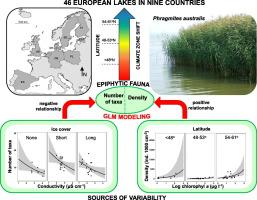Science of the Total Environment ( IF 8.2 ) Pub Date : 2020-12-03 , DOI: 10.1016/j.scitotenv.2020.144117 Ryszard Kornijów , Małgorzata Dukowska , Joanna Leszczyńska , Carl Smith , Erik Jeppesen , Lars-Anders Hansson , Mirva Ketola , Kenneth Irvine , Tiina Nõges , Maria Sahuquillo , Maria Rosa Miracle , Elisabeth Gross , Timo Kairesalo , Ellen van Donk , Elvira de Eyto , Francisco García-Criado , Maria Grzybkowska , Brian Moss

|
So far, research on plant-associated macroinvertebrates, even if conducted on a large number of water bodies, has mostly focused on a relatively small geographical area, permitting limited conclusions to be drawn regarding potentially broader geographic effects, including climate. Some recent studies have shown that the composition of epiphytic communities may differ considerably among climatic zones. To assess this phenomenon, we studied macroinvertebrates associated with the common reed Phragmites australis (Cav.) Trin. ex Steud in 46 shallow lakes using a common protocol. The lakes, located in nine countries, covered almost the entire European latitudinal range (from < 48oN to 61oN) and captured much of the variability in lake size and nutrient content in the region. A Poisson Generalised Linear Mixed Model (GLMM) showed the number of macroinvertebrate epiphytic taxa to be negatively associated with water conductivity and positively associated with medium ice cover duration (approximately 1 month). A Gamma GLMM showed a positive effect of chlorophyll a on the density of macroinvertebrates, and a significantly greater density in lakes located at the lowest and highest latitudes. Individual taxa responded differently to lake environmental conditions across climate zones. Chironomidae dominated in all climate zones, but their contribution to total density decreased with increasing latitude, with progressively greater proportions of Naidinae, Asellidae, Ephemeroptera and Trichoptera. Our study demonstrates that epiphytic macroinvertebrate fauna, even when analyzed at low taxonomic resolution, exhibits clear differences in diversity, relative abundance of individual taxa and total density, shaped both by geographic and anthropogenic variables. The results were discussed in the context of climate change. To our best knowledge this is the first study to examine epiphytic fauna carried out on a European scale.
中文翻译:

欧洲浅湖附生芦苇相关大型无脊椎动物群落的分布模式
到目前为止,即使是在大量水体上进行的与植物相关的无脊椎动物的研究,也大多集中在相对较小的地理区域上,因此对于包括气候在内的潜在更广泛的地理效应,我们只能得出有限的结论。最近的一些研究表明,气候带之间附生群落的组成可能存在很大差异。为了评估这种现象,我们研究了与普通芦苇芦苇(Cav。Trin)相关的大型无脊椎动物。使用通用协议在46个浅湖中使用ex Steud。位于9个国家/地区的湖泊几乎覆盖了整个欧洲的纬度范围(从<48 o N到61 o NN),并捕获了该地区湖泊大小和养分含量的大部分变化。泊松广义线性混合模型(GLMM)显示,大型无脊椎动物附生类群的数量与水电导率呈负相关,与中等冰盖持续时间(约1个月)呈正相关。Gamma GLMM显示出叶绿素a的积极作用大型无脊椎动物的密度,位于最低和最高纬度的湖泊中的密度明显更大。各个分类单元对整个气候区中湖泊环境条件的反应不同。在所有气候区中,猫科都占主导地位,但它们对总密度的贡献随着纬度的增加而降低,其中鹦鹉螺科,天蛾科、,翅目和毛鳞翅目的比例逐渐增加。我们的研究表明,附生的大型无脊椎动物动物,即使在低分类学分辨率下进行分析,也显示出明显的差异,其多样性,单个分类群的相对丰度和总密度受地理和人为因素影响。在气候变化的背景下讨论了结果。











































 京公网安备 11010802027423号
京公网安备 11010802027423号